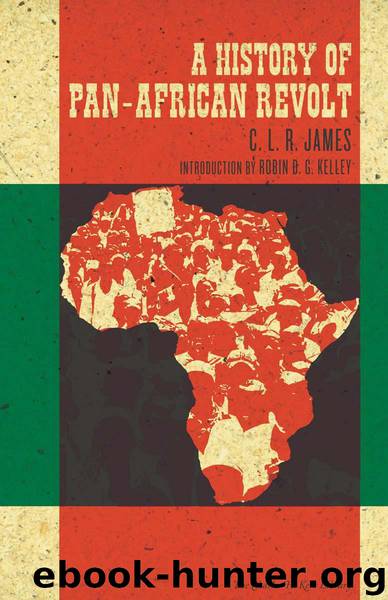A History of Pan-African Revolt (The Charles H. Kerr Library) by James C. L. R

Author:James, C. L. R. [James, C. L. R.]
Language: eng
Format: azw3
Publisher: PM Press
Published: 2012-11-30T16:00:00+00:00
The Old Colonies
Let us begin with revolts in one of the oldest colonies on the West Coast, Sierra Leone. The Negroes in the actual colony are some of the most advanced in education and should be grouped with those of the West Indies rather than with those in Central or Eastern Africa. Freetown, the capital, for instance, was until recent years a municipality. The hinterland is, however, a protectorate where the less developed Africans are governed by the method of indirect rule.
At the end of the last century there were two Negro communities, one with its own press, barristers-at-law, doctors and other intelligentsia, and on the other hand the natives in the interior, the new Africa and the old. These two communities were divided. Those with generations of British education had an outlook similar to that of the majority of Negroes in the West Indies: they regarded the African tribes as barbarous and uncivilized. The African tribes looked upon these Europeanized blacks as black white men. In 1898 a revolt burst in the protectorate. The natives resented the paying of the poll tax and the Mendi, a famous fighting tribe, had a special grievance of their own: they objected to corporal punishment. So much did they oppose it, that they would not send their children to the missionary schools where the missionaries sometimes beat them. The tribes completely wiped out some battalions of West Indian blacks who were sent against them, and it is claimed by Negroes who were in Sierra Leone at the time that certain white battalions were also completely destroyed. The great massacres of government soldiers took place at Sherbro and Mofeno. The revolt was of course put down, many hundreds of natives being killed. The insurgents killed not only white and black soldiers and every missionary they could put their hands on, but also certain of the Europeanized blacks as well. They looked upon all of these as members of one exploiting, arrogant group. The war, however, has marked the beginning of a change.
The conflict of capital and labor is intensified by the fact that capital is usually white and labor black; this in a continent where the whites have always sought to justify their economic exploitation and social privilege by the mere fact of difference of color. The class conflict, bitter enough in countries where the population is homogeneous in color, has an added bitterness in Africa, which has been strengthened by the growth of nationalism among the post-war intelligentsia. The politically conscious minority increasingly realize that their future is with the developing Africans rather than with the European traders. Further, they are Africans in Africa—not the descendants of Africans, as in the West Indies. The result is a growing solidarity between the blacks, chiefly workers in the colony and the more untutored Africans in the protectorate. Black politicians in the colony attribute the ill-feeling in 1898 to white propaganda aimed at dividing potential allies, and they have common ground in that they are Negroes in a continent where to be black is to be inferior.
Download
This site does not store any files on its server. We only index and link to content provided by other sites. Please contact the content providers to delete copyright contents if any and email us, we'll remove relevant links or contents immediately.
| African-American Studies | Asian American Studies |
| Disabled | Ethnic Studies |
| Hispanic American Studies | LGBT |
| Minority Studies | Native American Studies |
Cecilia; Or, Memoirs of an Heiress — Volume 1 by Fanny Burney(31351)
Cecilia; Or, Memoirs of an Heiress — Volume 3 by Fanny Burney(30949)
Cecilia; Or, Memoirs of an Heiress — Volume 2 by Fanny Burney(30907)
The Great Music City by Andrea Baker(21621)
We're Going to Need More Wine by Gabrielle Union(18086)
Bombshells: Glamour Girls of a Lifetime by Sullivan Steve(13119)
Pimp by Iceberg Slim(12947)
All the Missing Girls by Megan Miranda(12775)
Fifty Shades Freed by E L James(12463)
Talking to Strangers by Malcolm Gladwell(11908)
Norse Mythology by Gaiman Neil(11901)
Crazy Rich Asians by Kevin Kwan(8372)
Mindhunter: Inside the FBI's Elite Serial Crime Unit by John E. Douglas & Mark Olshaker(7850)
The Lost Art of Listening by Michael P. Nichols(6484)
Enlightenment Now: The Case for Reason, Science, Humanism, and Progress by Steven Pinker(6414)
Bad Blood by John Carreyrou(5782)
The Four Agreements by Don Miguel Ruiz(5533)
Weapons of Math Destruction by Cathy O'Neil(5048)
We Need to Talk by Celeste Headlee(4881)
